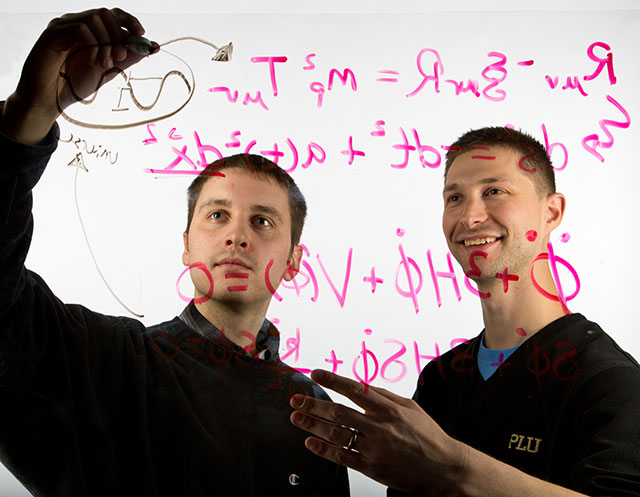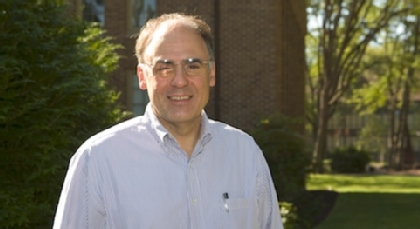Page 1 • (7 results in 0.024 seconds)
-

The K.T. Tang Faculty Excellence Award in Research recognizes up to two faculty scholars who have made significant contributions to their disciplines through disseminating research findings related to the discovery, integration, or application of knowledge. Chair of the Physics Department Bret Underwood was one of…
, research, and service. Their peers have nominated and selected the recipients, signifying their high regard among those who know them well. Underwood’s scholarship stands at the forefront of theoretical physics, seamlessly navigating the intersections of Einstein’s general relativity, cosmology, high-energy physics, string theory, and loop quantum gravity. His outstanding achievements are reflected in his 28 refereed publications since 2006 and in the recognition earned through three invitations to
-

The K.T. Tang Faculty Excellence Award in Research recognizes up to two faculty scholars who have made significant contributions to their disciplines through disseminating research findings related to the discovery, integration, or application of knowledge. Chair of the Physics Department Bret Underwood was one of…
selected the recipients, signifying their high regard among those who know them well. Underwood’s scholarship stands at the forefront of theoretical physics, seamlessly navigating the intersections of Einstein’s general relativity, cosmology, high-energy physics, string theory, and loop quantum gravity. His outstanding achievements are reflected in his 28 refereed publications since 2006 and in the recognition earned through three invitations to serve as a keynote speaker at major conferences and
-
The UMass Lowell Physics Department is a leader in nuclear physics, radiation science, terahertz technologies, advanced materials, photonics device fabrication techniques, and biomedical photonics applications. Our campus is located twenty-five miles northwest of Boston, with a student population of over 18,500. We have 30 full-time…
full-time faculty, approximately 70 graduate students and over 100 undergraduate majors in the Department of Physics and Applied Physics. The Department has external grant and contract funding of over $10 million per year. Faculty research areas include advanced materials, astronomy and astrophysics, biomedical optics, biophysics, cosmology, medical physics, electromagnetic metamaterials, nanoscience and laser applications, nuclear physics (both fundamental and applied), photonics, plasma physics
-

Auberry Fortuner ’13 and Assistant Professor Bret Underwood did research into understanding what gave rise to the expansion of the universe. (Photo by John Froschauer) Modeling the Early Universe By Katie Scaff ’13 None of us was around for the Big Bang , but one…
second after the Big Bang, trying to understand the conditions that gave rise to the cosmic inflation in which the universe grew exponentially. “Understanding how the world really works is really enjoyable for me,” Fortuner said. The Tacoma native knew next to nothing about cosmology when he began working on the project less than a year ago, but now he’s exploring territory uncharted by researchers. Fortuner worked under the direction of Bret Underwood, Assistant Professor of Physics, on the student
-

Starkovich named provost By Greg Brewis Steven P. Starkovich has been named provost and dean of graduate studies through the 2011-12 academic year. Provost Steven P. Starkovich He had been serving as acting provost this year during the sabbatical leave of Patricia O’Connell Killen. She…
he was finishing his Ph.D. from the University of Victoria, British Columbia. He has been teaching continuously ever since. In 1997 he was hired into a tenure-track position, and since 2001 has been associate professor of physics. He has served the university as a department chair and has extensive experience on the Faculty Affairs Committee and Budget Advisory Committee. Starkovich’s professional academic expertise is in general relativity and cosmology. As an undergraduate he studied
-

TACOMA, WASH. (Aug. 10, 2016)- When Justin DeMattos ’19 enters his junior year at Pacific Lutheran University in a few weeks, he will be coming off an internship experience that’s out of this world (quite literally). DeMattos, a physics major and computer science minor, traveled…
and I love working in the lab. I’m not sure yet if I’d be willing to do what I’m working on right now just because it’s only computer science for the most part. I really haven’t done a lot of physics in this internship. I was actually talking to my mentor the other day, who is a cosmologist. He likes to do physics problems as well, and he’s working on all computer science things. He said he finds cosmology a bit more interesting because that’s his field. That’s something I’ve also thought about
-

Associate Professor of Biology Jacob Egge works with students during a summer semester research project. (Photo by PLU Photographer John Froschauer) Faculty-Student Research Provides a Cornerstone of the PLU Mission By Pacific Lutheran University Marketing & Communications and the Office of the Provost This year’s…
years. As a young scientific subject, cosmology now has allowed us to comprehend our cosmos through observational data and detailed theories. With the support of increasingly precise data, cosmology keeps perfecting the model of our Universe and probing further back into the past. After decades of development, cosmologists are able to understand the evolution of our Universe all the way back to the billionth of a second in time, which we call the very early Universe. During this time, the Universe
Do you have any feedback for us? If so, feel free to use our Feedback Form.


